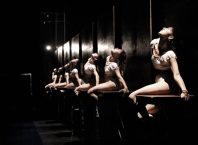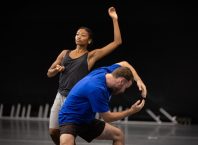
Some scenes are so painful to watch that the impulse to cover one’s eyes is difficult to restrain. I feel myself cringe as I gaze, muscles contracting, and remind myself that it is only a performance on a stage. The violence is not real.
Israeli contemporary dance is replete with images of violence and domination, yet no choreographer makes me cringe quite like Yasmeen Godder. Godder’s choreography relentlessly pokes and probes existential wounds, creating a dynamic encyclopedia of human ills. Fear, loneliness, anger, alienation, aggression, and jealousy play across the stage, unrelieved by compassion. Depicting the emotional landscape of a generation desensitized by information overload, Godder’s latest work, “Singular Sensation”, appearing Friday, April 10th at the Suzanne Dellal Center in Tel Aviv, pushes experience to the extreme once more.
“I’m Mean I Am”, which premiered in 2006, meticulously examined the intimacy and anxiety of the creative process in the studio, the dancers manipulating one another like objects, alternately seducing and torturing one another to the point where the two acts are indistinguishable. In contrast to this over-involvement, the five dancers in “Singular Sensation” are isolated and remain disconnected from one another even when they touch. If “I’m Mean I Am” takes place in the studio, then “Singular Sensation” is located center stage, both in its somewhat oblique reference –whether intended or not – to “A Chorus Line”, and in its treatment of similar themes (the desire for attention and sensation) sharpened to perverse perfection with self-reflective humor.
Relating closely to the world of popular entertainment, mass media and the incessant titillation of the internet, “Singular Sensation” is not to be confused with any of the above. The stage floor is stark white, curving up at either end, the back wall is black. A male dancer, Eran Shanny, walks casually out onto the stage, then stands, gazing apprehensively in all directions. Suddenly posing, he arches back, undulates forward and stands still again, as if waiting for a reaction. He jerks out his hip, sticks out his tongue, posing, and then falls convulsed on the floor in pleasure or pain, a smile cutting the surface of his face. One by one, the dancers emerge, each involved with his or her image, fears and tics, barely noticing one another, yet constantly looking out towards an invisible, omnipresent observer.
Godder’s sense of timing and space is compelling and the harsh human portrait is conveyed with expressive fluency of motion by the dancers with tender attention to small moments and gestures. Red and green play against this black and white background, an aesthetically pleasing combination whose employment here triggers disturbing associations of bile and blood. Tsuf Itschaky, a tall, muscular dancer whose countenance retains a suggestion of innocence, is initiated into the ritual search for sensation in a tribal frenzy where extreme sensory deprivation is the prelude to ecstasy. Face covered in a stocking then wrapped with plastic wrap, eyes masked with goggles that have flashing red lights, spaghetti stuffed in his ears and oranges in his hands, only his legs and feet are bare as the others lift him and swirl his feet into a gelatinous red pool.
Godder’s work is singularly disturbing, to the point of being uncomfortable to view, yet I force myself not to look away. With instant access offered by multiple media to virtually any and all information, a world of sensation is at our fingertips. Desensitized by the constant barrage of images and onslaught of words, we may all too easily find ourselves gazing dispassionately at human suffering as if we were watching a show, eagerly following the plot and movement. Perhaps we should feel uncomfortable.
Image credit: Tamar Lamm
Performance: Friday, April 10th at 22:00
Suzanne Dellal Center Tel Aviv
Tickets: 03-5105656
www.suzannedellal.org.il
Information: www.yasmeengodder.com





